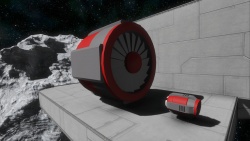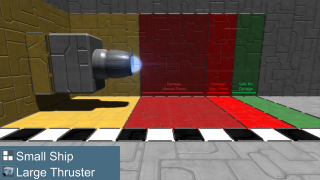推进系统
推进器是所有飞船或者是没有空间锚的空间站移动的主要方式。推进器可以提供飞船一个线性的推力而不会因为所处飞船位置的不同而产生力矩、扭转和旋转(陀螺仪)。只要推进器被连接至了一个整体(而不是异整体或者通过起落架而连接整体),他们都会从整体的质量中心提供推力,因此推进器的摆放位置还是稍有讲究的。游戏中有两种常尺度推进器: 标准推进器,一种使用电力 的离子推进器;氢推,一种使用氢气作为燃料,更为强劲但使用局限也较大的推进器。 在Update 01.105前,推进器有两个模式:常尺度推进和惯性抑制。常尺度推进用于鼠标和键盘操作的人工航行和控制速度(thrust override slider),惯性抑制则会自动额外消耗50%的电力以提供10倍的惯性抑制力。推进器在惯性抑制打开并且飞船仍在凭借惯性前行的情况下会发挥作用并逐渐使船停下。因此在此次更新前,让船停下会比让船加速更为容易。
Before Update 01.107, all Small Ship thrusters would receive a 5x boost to thrust when under the automatic control of inertial dampeners (not the player or 'thrust override') attempting to stop the ship, for no increase in both power usage or fuel usage.
Currently all kinds of thrusters (whether small or large ship) do not have any special super-dampening capabilities beyond their rated maximum thrust and power consumption.
Contents
Thrusters
| Thruster | Block size | Dimensions [size in m3] |
Maximum Thrust [kN] |
Mass [kg] |
Max Power Consumption [kW] |
Thrust-to-Mass [kN/kg] |
Thrust-to-Size [kN/m3] |
Thrust-to-Fuel [kN/kW] or [kN/H] |
Fuel Consumption [H/s] or [kg of U/s ] | |
|---|---|---|---|---|---|---|---|---|---|---|
| |
Large Thruster | |
3x4x2 [375m3] | 3600 | 43200 | 33600 | 0.0833 | 9.6 | 0.1071 | 0.0093 kg |
| |
3x4x2 [3m3] | 144 | 721 | 2400 | 0.1997 | 48 | 0.060 | 0.00067 kg | ||
| Small Thruster | |
1x2x1 [31.250m3] | 288 | 4384 | 3360 | 0.0657 | 9.216 | 0.0857 | 0.00093 kg | |
| |
1x2x1 [0.250m3] | 12 | 93 | 201 | 0.1290 | 48 | 0.0597 | 0.000056 kg | ||
| |
Large Hydrogen Thruster | |
3x3x3 [421.875m3] | 6000 | 6940 | 10000* | 0.8646 | 14.222 | 0.9336 | 6,426.7 H |
| |
3x3x3 [3.375m3] | 400 | 1222 | 800* | 0.3273 | 118.5185 | 0.778 | 514.1 H | ||
| Small Hydrogen Thruster | |
1x1x1 [15.625m3] | 900 | 1420 | 1700* | 0.6338 | 57.6 | 0.8238 | 1,092.5 H | |
| |
1x1x1 [0.125m3] | 82 | 334 | 170* | 0.2455 | 656 | 0.7505 | 109.2 H | ||
| |
Large Atmospheric Thruster | |
3x3x5 [703.125m3] | 5400 | 33834 | 16360 | 0.1596 | 7.68 | 0.3301 | 0.00454 kg |
| |
3x3x5 [5.625m3] | 408 | 4244 | 2400 | 0.0961 | 72.53 | 0.1700 | 0.00067 kg | ||
| Small Atmospheric Thruster | |
1x1x3 [46.875m3] | 420 | 4072 | 2360 | 0.1031 | 8.96 | 0.1780 | 0.000656 kg | |
| |
1x1x3 [0.375m3] | 80 | 539 | 701 | 0.1484 | 213.33 | 0.1141 | 0.000195 kg | ||
Ion Thruster (Electrical)
- All standard Electric-based Ion thrusters will consume a minimum of 0.002 kW (2 Watts), even when not in use. They use electricity to generate thrust, their power consumption scales linearly with what percentage (as seen on the thrust override slider) the thruster is operating at. It's effectiveness is inversely dependent on the density of the atmosphere, having an actual effectiveness anywhere from 30% at minimum to full effectiveness outside planetary atmospheres - becoming increasingly less effective the thicker the atmosphere.
Hydrogen Thruster
- All Hydrogen-based thrusters require a Conveyor connection to a source of Hydrogen such as an Oxygen Generator or a Hydrogen Tank. (*) Hydrogen based Thrusters despite having a 'power consumption' rating will not actually consume electrical power they ONLY consume Hydrogen from a hydrogen source accessed via conveyors. Their only electrical requirements will be for the hydrogen sources that store or make hydrogen and the Conveyor system. Each Hydrogen Thruster consumes a tiny amount of Hydrogen even if not active (as seen with its 'pilot light'), much like the minimum that electric-based thrusters have. Their effectiveness is entirely unaffected by the presence of planetary atmospheres, being equally effective everywhere.
Atmospheric Thruster
- All atmospheric thrusters thrust output is entirely dependent on the density of the atmosphere around the thruster and only work in planetary atmospheres, being most powerful near the surface and becoming linearly less powerful further out. Typically the thruster will never achieve it's rated maximum during usual play even directly on the surface (which is typically around 90% max efficiency). They much like standard thrusters use electricity to function and consume a minimum amount of 0.002 kW (2 Watts) even when not in use.
Effectiveness In Natural Gravity
To get an idea how many thrusters are needed to make a ship hover in the air while under the influence of natural gravity,
the following calculation should help:
Lift [kg] = engine force [N] * effectivity [unitless] / acceleration due to gravity [m/s²]
Example: 1 large small ship thruster has a force magnitude of 408,000 N at sea level. (Here an effectiveness of 90% is assumed.)
So on an earth-like planet on sea level it can lift:
L = (408,000 N * 0.9) / 9.81 m/s² = 37,431 [kg]
Where 9.81 m/s² = 1.0 g on Earth.
Or to just check if it will fly with 4 thrusters and a mass of 120,000 kg:
F = (4 * 408,000 N * 0.9) m = 120,000 kg a[min] = 9.81 m/s² a[curr] = (4 * 408,000 * 0.9) / 120,000 kg = 12.24 m/s² > 9.81 m/s² ===> will fly!
So if the ships downward thrusters total lift is greater than the ships mass,
the ship will be able to hover and fly.
This value decreases linearly with the decreasing air density in greater heights. The air density is different for each planet type. As is the natural gravity constant.
- Online calculator
Online calculator to calculate the thrust at planets and moons.
- Note
One should also keep in mind, that depending on the ships orientation during maneuvering, not all downward thrusters will actually contribute 100% to the ships lift.
If the thrusters are angled away from the the planets center of gravity, their effective lift value will decrease accordingly. A thruster angled at 45 degree will only contribute 70.71067812% (cos45x100%) of its total force for lift. If not taken into account, this can make a ship plummet to the ground when not maneuvering it carefully
due to insufficient lateral thruster force when rolling the aircraft too much for example. So this should be calculated or tested before actually finishing a ship design to prevent a bad surprise.
- Note2
The "x5" / "x10" inventory setting will also have an effect on the calculation.
The game will divide the cargo mass by the set inventory multiplier when calculating thruster lift.
So a cargo mass of 100,000 kg will only count as 10,000 kg if "x10" inventory multiplier is set.
This means, a ship with atmospheric thrusters can potentially lift 10 times more cargo mass with the same thrust than it normally could, if a "x10" inventory multiplier is set.
However, the right HUD panel when inside of a ship doesn't correct the cargo mass to reflect the mass taken into account for lift.
So that means, when having a ship with net mass of 100,000 kg and transporting 100,000 kg of cargo with a 10x inventory multiplier,
the panel will show 200,000 kg of mass while in reality it will take only 110,000 kg (ship mass + cargo/10) of mass into account for calculation of lift ability.
Thruster Damage
If 'Thruster Damage' is enabled for a map or server, thrusters will deal damage while active to any blocks directly behind within a certain distance with exception to small thrusters damaging large ship blocks, making it possible to build 'landing pads'. If this occurs, blocks adjacent to the block/s in "the line of fire" will also be damaged in a cross-pattern. If the block is too close to the thruster, this can even damage the thruster, causing it to explode. The "danger zone" varies in size based on the thrust being applied by the thruster. Large thrusters deal damage further than small thrusters. Likewise, thrusters on large ships deal damage further than those on small ships.
This table (and the images below it) indicate the damage distances for small and large thrusters and ships. They apply only to blocks directly behind the thruster, and do not account for damage to adjacent blocks.
All thrusters from standard thrusters, hydrogen and Atmospheric deal thruster damage to varying degrees if enabled, generally the more powerful the thruster the larger the danger zone becomes.
| Damage Distance | |||
| Blocks | Metres | ||
| Small Ship | Small Thruster | 3 sb | 1.5m |
| Large Thruster | 5 sb | 2.5m | |
| Large Ship | Small Thruster | 2 lb | 5.0m |
| Large Thruster | 5 lb | 12.5m | |
- sb = small-ship blocks (0.5m each)
- lb = large-ship blocks (2.5m each)






